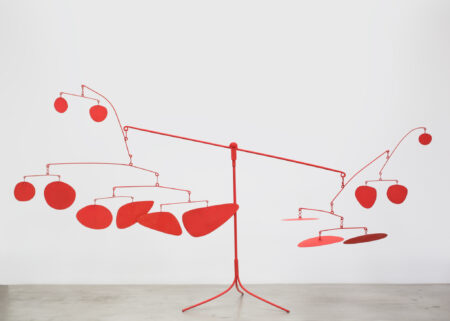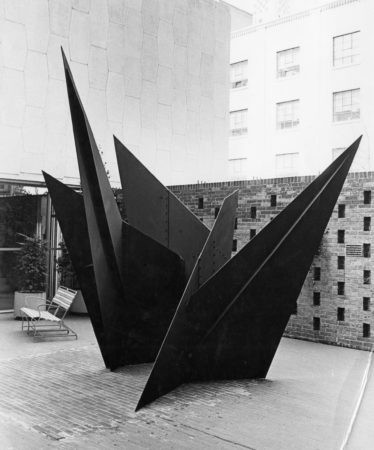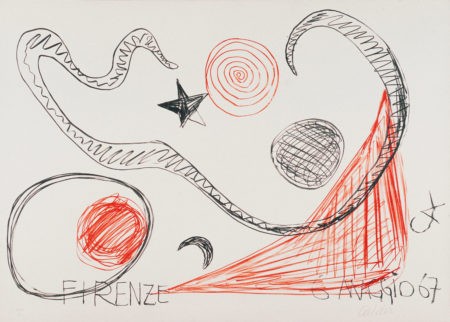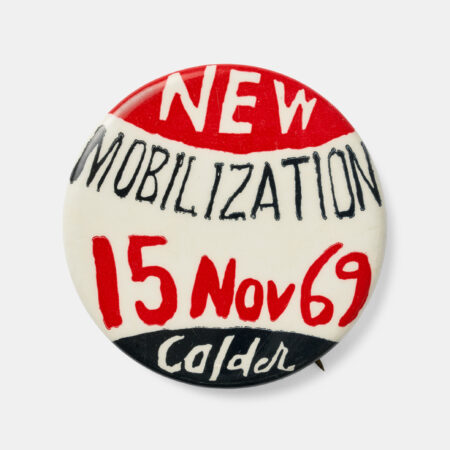Archive
Hans Richter directs and films Alexander Calder: From the Circus to the Moon.
CF, project fileDiego Masson commissions Earle Brown to compose a piece of music for the Percussion Quartet of Paris. The two men travel to Saché to meet with Calder, and Brown begins to work on the score, which he titles Calder Piece.
CF, project fileCalder leaves Roxbury and flies to France to oversee work on six large stabiles at Etablissements Biémont.
Calder 1966, 265Calder returns to the United States.
CF, passportFrank Perls Gallery, Beverly Hills, exhibits “Calder: Mobiles, Stabiles and Gouaches.”
CF, exhibition filePerls Galleries, New York, exhibits “Alexander Calder: 1963.”
CF, exhibition fileThe Calders’ grandson, Alexander S. C. Rower, is born in New York to Mary and Howard Rower.
CF, birth certificateThe Calders return to France.
CF, passportCalder is awarded the Edward MacDowell Medal. Art historian Meyer Schapiro, the speaker at the Medal Day ceremony in New Hampshire, receives the medal on Calder’s behalf.
After eighteen months, the new studio at Le Carroi is completed.
Calder 1966, 264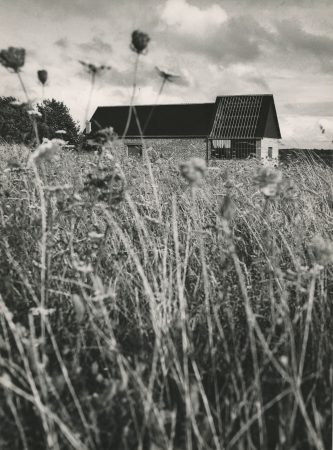
Galerie Maeght, Paris, exhibits “Alexander Calder: Stabiles.” Catalogue essays include “L’ombre de l’avenir” by James Jones and “Qu’est-ce qu’un Calder?” by Michel Ragon, with cover and illustrations by Calder.
CF, exhibition fileLa Comédie de Bourges performs La Provocation, with sets and costumes designed by Calder and choreography by Pierre Halet. The play opens in Bourges and is performed the following year in Tours (10 May 1964) and Paris (4 November 1964).
CF, project file1964
Art in America and Perls Galleries publishes Calder’s Circus, a portfolio of sixteen unbound lithographs with a text by Cleve Gray and a reproduction of a letter from Miró describing Calder’s 1932 performance of Cirque in Montroig.
CF, object fileCalder completes the monumental standing mobile Chef d’orchestre for Earle Brown’s Calder Piece. The mobile functions as both a “conductor,” determining the sequence and speed of the music, and as one of the instruments whereupon the elements are struck or “played.”
CF, project fileThe Calders spend two weeks in Morocco; they visit Marrakech, Fès, Ouarzazate, and Casablanca.
AAA, Calder to Gray, 2 FebruaryThe Calders sail on the SS France for New York, departing from Le Havre.
CF, passport; AAA, Calder to Gray, 5 MayThe Calders arrive in New York on the SS France and travel to Roxbury.
CF, passportPerls Galleries, New York, exhibits “Calder: Circus Ink Drawings 1931–1932.”
CF, exhibition fileGrosvenor Gallery, London, presents “Miró: Graphics, Calder: Mobiles, Ch’i Pai-shih: Paintings.”
CF, exhibition fileCalder attends the opening preview of “Alexander Calder: A Retrospective Exhibition” at the Solomon. R. Guggenheim Museum, New York.
CF, photography file; CF, exhibition file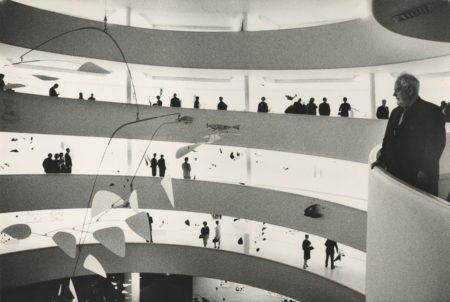
Solomon R. Guggenheim Museum, New York, exhibits “Alexander Calder: A Retrospective Exhibition.” Thomas M. Messer curates the exhibition, which travels to St. Louis, Toronto, Milwaukee, and Des Moines.
CF, exhibition file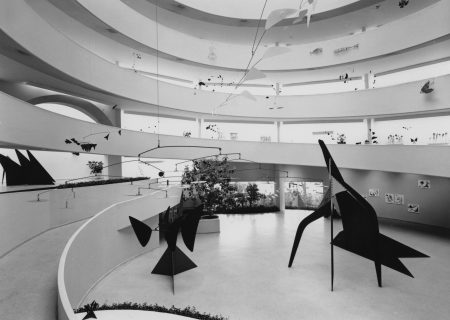
The Museum of Fine Arts, Houston, exhibits “Alexander Calder: Circus Drawings, Wire Sculpture and Toys.” Sweeney curates this exhibition.
CF, exhibition file1965
Before leaving for France, Calder meets with I. M. Pei to discuss a large stabile for the Massachusetts Institute of Technology.
Calder 1966, 273The Calders sail on the SS France, arriving at Le Havre.
Calder 1966, 270; CF, passportThe American Academy of Arts and Letters, New York, formally inducts Calder as a member.
Lipman 1976, 336Musée National d’Art Moderne, Paris, exhibits “Calder,” a retrospective. Jean Cassou writes the catalogue preface.
CF, exhibition file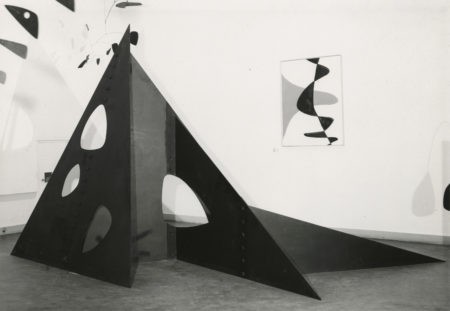
Calder arrives in Brussels.
CF, passportCalder departs from Belgium.
CF, passportCalder designs sets for Eppur Si Muove, a ballet choreographed by Joseph Lazzini and performed at the Marseilles Opera.
CF, project fileThe Calders return from Europe, arriving in New York.
CF, passportMiró flies to New York from Paris. He visits Calder in Roxbury.
CF, photography fileArchitect Harry Seidler and wife Penelope visit the Calders in Roxbury. Two years later, Calder completes the commission of Crossed Blades for the Australia Square Tower.
CF, project file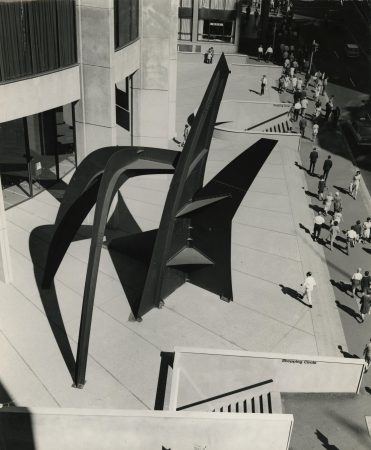
Calder dedicates Le Guichet, a monumental stabile installed in Lincoln Center Plaza, New York.
CF, Calder to Lipman, 24 November; CF, object file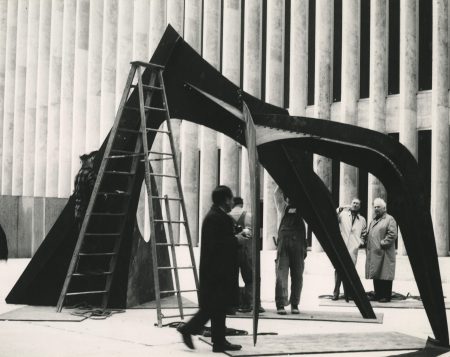
Calder, a member of Artists for SANE (Committee for a Sane Nuclear Policy), participates in a march to protest against the Vietnam War in Washington, D.C.
Lipman 1976, 3371966
Carlos Vilardebó films Mobiles, narrated by Calder and produced by Pathé Cinema, Paris.
CF, project fileOn behalf of SANE, the Calders publish a full-page ad in the New York Times: A New Year, New World. Hope for: An end to hypocrisy, self-righteousness, self interest, expediency, distortion and fear, wherever they exist. With great respect for those who rightly question brutality, and
speak out strongly for a more civilized world. Our only hope is in thoughtful Men—Reason is not treason.
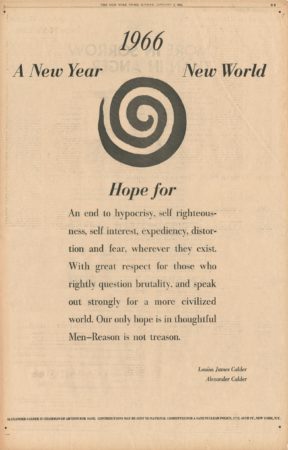
The Calders arrive in Le Havre after a trip on the United States, returning to Saché.
CF, passport; Calder 1966, 276In a hopeful gesture, Calder donates Object in Five Planes, a monumental stabile, to the United States Mission at the United Nations, New York, and dubs it Peace. The dedication ceremony takes place in May, when Calder returns from Europe.
New York Times, 8 February; CF, project filePerls Galleries, New York, exhibits works by Calder.
CF, exhibition fileGalerie Maeght, Paris, exhibits “Calder: Gouaches et Totems.” The catalogue includes “Oiseleur du fer,” a poem by Jacques Prévert; “Alexander Calder” by Meyer Schapiro; “Les Gouaches de Calder” by Nicholas Guppy; and “De l’Art Students League aux Totems,” excerpted from
Calder’s autobiography, to be published in May of 1966. Cover and illustrations are by Calder.
The Calders arrive in New York.
CF, passportThe Calders return to France.
CF, passportPantheon Books publishes Calder: An Autobiography with Pictures. Calder had been dictating the text to his son-in-law, Jean Davidson, over the previous year and a half.
CF, publication fileThe Calders arrive in the United States.
CF, passportCalder attends the dedication of the monumental stabile La Grande voile in McDermott Court at the Massachusetts Institute of Technology.
CF, project file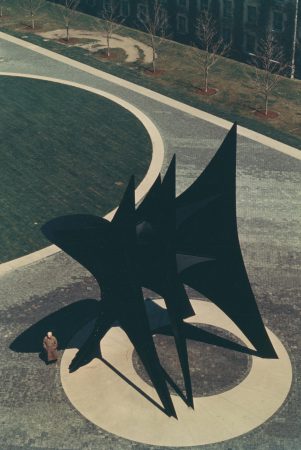
Calder is awarded an honorary Doctor of Arts degree from Harvard University.
CF, diplomaThe Calders return to France.
CF, passportThe Calders arrive directly to Washington, D.C.
CF, passportPerls Galleries, New York, exhibits “Calder: Jewelry.”
CF, exhibition fileThe Calders return to France.
CF, passportCalder and Louisa fly from Paris to Monaco to see his monumental standing mobile Quatre lances, recently installed above a pool on the esplanade of the Centennial Hall. They attend the dedication on the morning of 20 December with Princess Grace and Prince Rainier, returning to Paris that afternoon.
CF, Calder to Shahn, 9 January 1967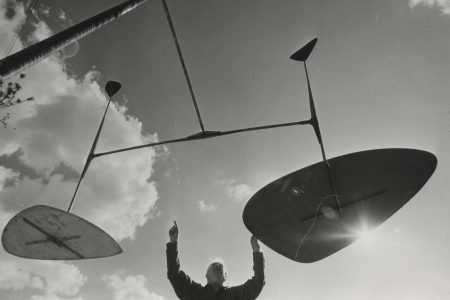
1967
Calder makes a gift of the large standing mobile Frisco to the Museo de la Habana, Cuba. The Cuban Government issues a postage stamp of it.
CF, exhibition file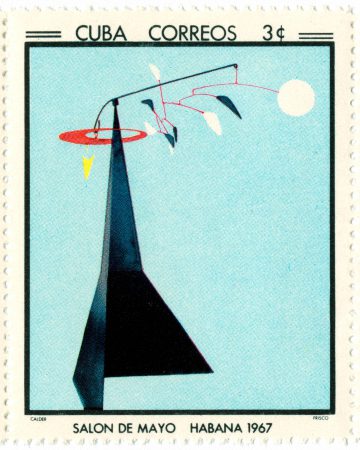
The Museum of Modern Art, New York, exhibits “Calder: 19 Gifts from the Artist.”
CF, exhibition fileCalder Piece, written by Earle Brown and featuring Calder’s Chef d’orchestre, is performed by Diego Masson and the Percussion Quartet of Paris at the Théâtre de l’Atelier. After the premiere, Calder remarks, I thought you were going to hit it harder.
CF, project fileMathias Goeritz, an architect, writes to Calder in Saché, inviting him to create a stabile for the 1968 summer Olympic Games in Mexico City; Calder agrees.
CF, Calder to Goeritz, 29 AprilThe Calders arrive in New York.
CF, passportCalder and Louisa have dinner in New York at the home of daughter Mary.
CF, MCR datebookFrom New York, Calder travels to Montreal.
CF, MCR datebookCalder and Louisa have lunch in New York at the home of daughter Mary.
CF, MCR datebookCalder and Louisa attend the annual dinner of the National Committee for a Sane Nuclear Policy at the Waldorf-Astoria.
CF, MCR datebookCalder and Louisa have lunch in New York at the home of daughter Mary.
CF, MCR datebookThe Calders have lunch in New York with Calder’s sister, Peggy, at the home of daughter Mary.
CF, MCR datebookThe Calders depart for Roxbury.
CF, MCR datebookCalder, Louisa, and Klaus Perls fly to Des Moines, Chicago, and Montreal. Upon their return to New York, they have dinner at Del Pezzo with daughter Mary and others.
CF, MCR datebookCalder’s monumental stabile in unpainted stainless steel, commissioned by the International Nickel Company, is presented at the 1967 International and Universal Exposition (Expo ’67) in Canada, where the theme is “Man and His World.” I called it Three Discs, but
when I got over to Canada, they wanted to call it Man.
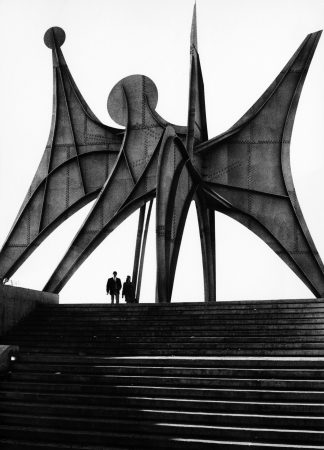
Calder and Louisa depart for France.
CF, MCR datebookCalder and Louisa travel to Italy, visiting Rome, Spoleto, Florence, Puglia, and Naples.
CF, Calder to Rower, 8 and 10 MayWhile in Florence, Calder creates a lithograph, Firenze, to commemorate the 1966 flood.
CF, object fileThe Calders travel to Berlin.
CF, passport; CF, Louisa to Mary, 14 MayThe Calders return to Italy. At the suggestion of Carandente, Massimo Bogianckino, artistic director of the Teatro dell’Opera, Rome, commissions Calder to develop a work for the stage. Calder begins Work in Progress in December 1967.
Carandente 1983, 231New York City holds an outdoor group exhibition, “Sculpture in Environment.” Given the choice of any site in the city, Calder places two stabiles, Little Fountain and Triangle with Ears, in Harlem.
New York Times, 2 September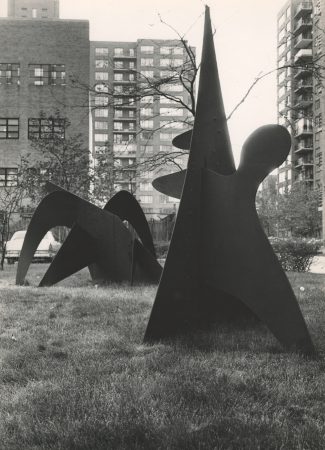
Calder sends final instructions from Saché for El Sol Rojo, the stabile he created for the 1968 summer Olympic Games in Mexico City.
CF, Calder to Goeritz, 8 NovemberPerls Galleries, New York, exhibits “Calder: Early Work–Rediscovered.”
CF, exhibition fileThe Calders arrive in the United States.
CF, passportCalder and Louisa have dinner at the home of daughter Mary.
CF, MCR datebookAfter spending Christmas in the United States, the Calders arrive in Mexico City, where Calder oversees work on the intermediate maquette for El Sol Rojo.
CF, Calder to Goeritz, 8 November1968
Calder and Louisa journey to the Yucatán.
CF, travel fileThe Calders stop off in New York for a few weeks before returning to France.
CF, passportMaison de la Culture in Bourges, France, exhibits “Calder: Mobiles, Stabiles, Sculptures, Gouaches.” The exhibition later travels to Musée des Augustins, Toulouse.
CF, exhibition fileCalder is awarded the Officer of the Légion d’Honneur of France, possibly on the opening date of the exhibition. The presentation is made by Henri Hoppenot, former ambassador to Washington.
CF, exhibition file; CF, awards fileCalder’s Work in Progress is performed by the Teatro dell’Opera, Rome. For thirty years I have been thinking about a production that would be entirely mine, form and music working together. I long ago discussed this with Massine, but he insisted on having dancers. I later made
stage sets, but this is not exactly what I wanted to do … for Satie’s Socrate, Pichette’s Nucléa, John Butler’s The Glory Folk in Spoleto, for Joe Lazzini in Marseille. The idea of a production that was totally mine had already come to me in spirit in 1926 when I finished the Cirque, and when I tried to frame it in a stage opening, amusing myself by thinking it an actual theatre.
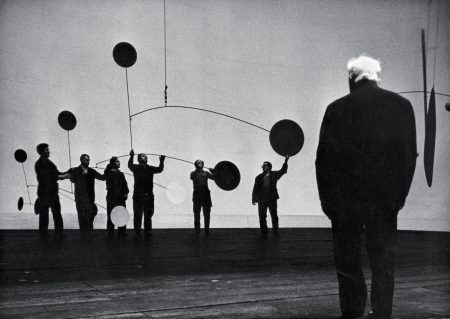
To celebrate Calder’s seventieth birthday, Klaus Perls gives an intimate party at the Colombe d’Or in Saint-Paul-de-Vence. Miró attends.
New York Times, 28 JulyGalerie Maeght, Paris, exhibits “Flèches.” The catalogue text includes “Un géant enfant” byCarandente and “Note sur les flèches” by Jacques Dupin, with cover and illustrations by Calder.
CF, exhibition fileThe Calders arrive in the United States.
CF, passportPerls Galleries, New York, exhibits “Calder / Space: Drawings 1930–1932; Gouaches 1967–1968.”
CF, exhibition fileCalder and Louisa have lunch in New York at the home of daughter Mary.
CF, MCR datebookThe Calders return to Mexico City, where they view El Sol Rojo in place at Aztec Stadium.
CF, Calder to Goeritz, 2 December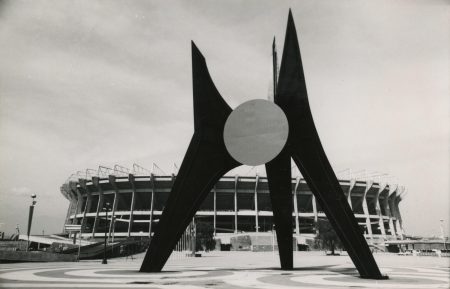
The Calders arrive in New York.
CF, MCR datebookThe Calders return to France.
CF, passport1969
Calder builds a new house adjacent to the Le Carroi studio in Saché.
Lipman 1976, 338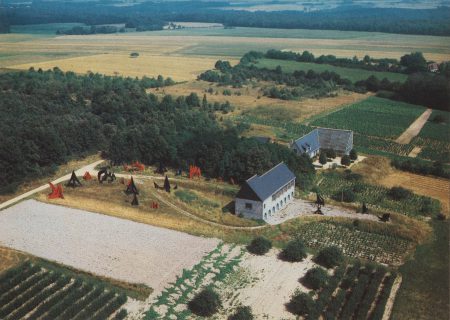
Janey Waney, commissioned by the N.K. Winston Corporation, is installed at the Smith Haven Mall in the Long Island village of Lake Grove. The force behind the site-specific project is the developer’s wife, Jane Holzer—or “Baby Jane,” a star of Andy Warhol’s films––for whom the sculpture was named.
CF, project file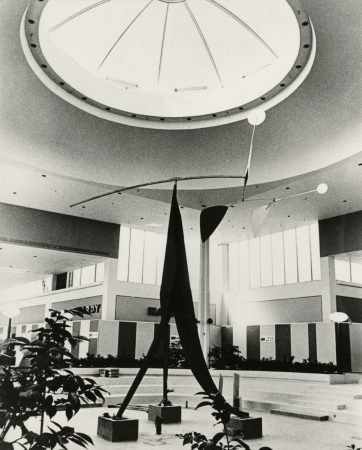
Fondation Maeght, Saint-Paul-de-Vence, France, exhibits “Calder,” a retrospective. Calder installs Morning Cobweb, a monumental walk-through stabile, as the entrance to the exhibition.
CF, exhibition file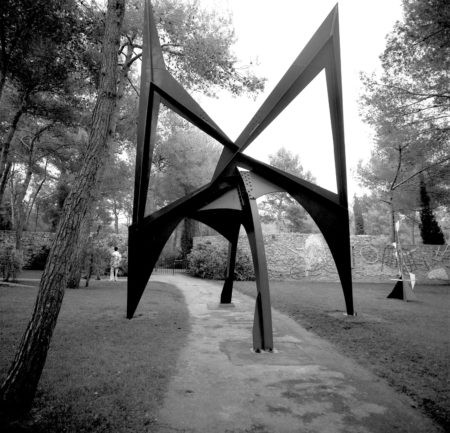
The Calders return to the United States.
CF, passportCalder attends the dedication ceremony for his commissioned monumental stabile Gwenfritz, which is installed outside the Museum of History and Technology, Smithsonian Institution, Washington, D.C.
CF, project file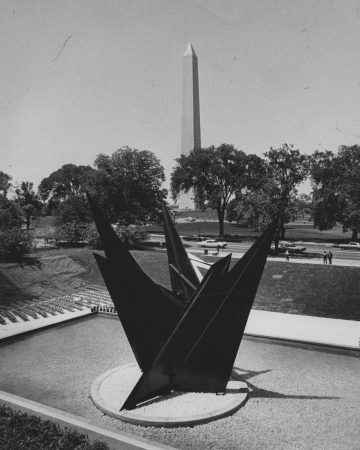
Stevens awards Calder the degree of Doctor of Engineering, Honoris Causa, on the fiftieth anniversary of his graduation.
CF, awards fileCalder attends the dedication ceremony for La Grande vitesse, a monumental stabile commissioned by the city of Grand Rapids, Michigan, in August 1967. This is the first sculpture to be funded by the public art program of the National Endowment for the Arts (NEA).
CF, project file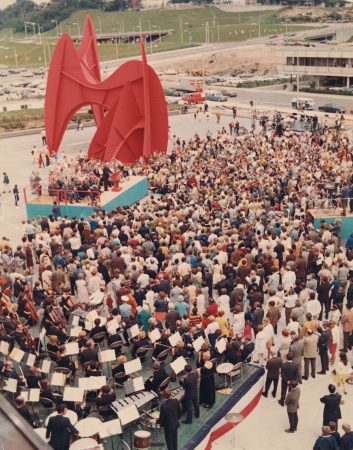
The Calders depart for France.
CF, MCR datebookPerls Galleries, New York, exhibits “Alexander Calder: Bronze Sculptures of 1944.”
CF, exhibition fileCalder designs a button for the mass protest against the Vietnam War in Washington, D.C., sponsored by the New Mobilization Committee to End the War in Vietnam.
CF, object fileCalder designs sets and costumes for Métaboles, choreographed by Joseph Lazzini, scored by Henri Dutilleux, and produced by Théâtre Français de la Danse.
CF, project file